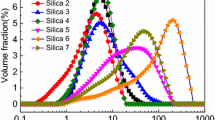Abstract
Commercial high ammonia (HA-NRL), low ammonia (LA-NRL), deproteinised (DP-NRL) and prevulcanised (PV-NRL) natural rubber latex concentrates were characterised for their colloidal properties using particle size and distribution analysis, Scanning Electron Microscopy (SEM), zeta potential analysis and rheology measurements. Particle size analysis showed HA-NRL, LA-NRL and PV-NRL to have bimodal distributions whereas DP-NRL showed a unimodal distribution. SEM showed HA-NRL, LA-NRL and PVNRL particles to be spherical whereas DP-NRL particles were made up of a mixture of spherical and pear-like shapes. Furthermore, HA-NRL, LA-NRL and DP-NRL particles were deformed and fused together unlike PV-NRL particles which retained their spherical shape. The zeta potential results indicate that all four latex concentrates follow a similar trend to the results obtained by previous researchers. Rheological studies were divided into steady state and oscillatory measurements. Shear thinning behaviour was observed for all four latex concentrates and fittings to the linearised Dougherty-Krieger equation showed HA-NRL, LA-NRL, DP-NRL and PV-NRL to have ø of 0. 787, 0.810, 0. 790 and 0.803 which corresponded to latex concentrations of 76.9 wt%, 79.2 wt%, 77.2 wt% and 78.4 wt%, respectively. Oscillatory measurements at a frequency of I Hz and ø = 0.62 gave tan c5 values of 1.28, 0.52, 0.96 and 1.41, respectively for HA-NRL, LA-NRL, DP-NRL and PV-NRL indicating a dominant viscous behaviour in HA-NRL and PV-NRL while LA-NRL and DP-NRL showed dominant elastic behaviour. A shift from dominant elastic to viscous behaviour for LA-NRL and DP-NRL was observed to occur at ø of ≈0.595 and 0.60, respectively.
Similar content being viewed by others
References
BOWERS, J. E. (1990) Natural Rubber Producing Plants for the United States. USDA, Cooperative State Research Service and National Agricultural Library. Beltsville, Maryland: NAL.
VAN BEILEN, J.B. AND POIRIER, Y. (2007) Establishment of New Crops for the Production of Nat. Rub. Trends Biotechnol., 25(11), 522–529.
VAN BEILEN, J.B. AND POIRIER, Y. (2007) Guayule and Russian Dandelion as Alternative Sources of Nat. Rubb. Crit. Rev. Biotechnol., 27(4), 217–231.
CORNISH, K. (1996) Hypoallergenic Natural Rubber Products from Parthenum argentatum (Gray) and Other Non — Hevea brasiliensis Species. US Patent 5,580,942.
Natural Rubber Statistics 2017, January — March, Credible Rubber Pricing Systems (CRSP), Kuala Lumpur: Malaysian Rubber Board.
LI, G.Y., WANG, Q.B., LI, T.Y., ZHOU, S.X. AND YU, H.Y. (2014) A Review oflnfluencing Factors on Latex Yield of Hevea brasiliensis. Chinese J. Ecol., 33(2), 510–517.
NUTTER, A.F. (1979) Contact Urticaria to Rubber. Br. J. Dermatol., 101, 597–598.
ICHIKAWA, N, MIYAMOTO AND Y, HAYASHI, M (2004) Low Allergenic Natural Rubber and Method of Preparing Low Allergenic Natural Rubber Latex, US Patent 6,784,281.
GEORGE, K.M., RAJAMMAL, G, AMMA, G, MATHEW, N.M. (2007) Preparation and Properties of Low Protein NR Latex Using Stabilised Liquid Papain. J. Rubb. Res., 10(3), 131–142.
MANROSHAN, S, MUSTAFA, A, MOK, K.L., KAWAHARA, S, AMIR - HASHIM M.Y. AND BOOTEN, K. (2009) Comparison between Sodium Dodecyl Sulfate and Polyfructose Surfactant Systems in Urea Deproteinisation of Natural Rubber Latex. J. Rubb. Res., 12(1), 1–11.
SUBRAMANIAM, A, YIP, E, NG, K.P. AND MOK, K.L. (1993) Extractable Protein Content of Gloves from Prevulcanised Natural Rubber Latex. In: Proc. Int. Rubb. Technol. Conf. and Workshop on Latex Proteins, Kuala Lumpur 1993, 76–80.
ENG, A.H., KODAMA AND S, KAWASAKI, H. (1999) Reduction of Water Extractable Proteins in Natural Rubber Latex Films by Ultrasonic Leaching System. J. Rubb. Res. 2(1), 23–28.
YIP, E AND CACIOLI, P. (2002) The Manufacture of Gloves from Natural Rubber Latex. J. Allergy Clin. Immunol., 110(2), S3–S14.
CHEN, S.F. (1988) Types, Composition, Properties, Storage and Handling of Natural Rubber Latex Concentrate. In: FOO, K.Y. AND CHUAH, P.G. (Eds) Notes on NR Examination Glove Manufacture, Kuala Lumpur: RRIM, 1988, p.1–12.
BLACKLEY, D.C. (1997) Polymer Latices Science and Technology, Vol.2, Types of Latices. London: Chapman and Hall.
LOWE, J.S. (1960) The Substrate for V.F.A. Formation in Natural Rubber Latex. 1.R.1, Trans, 36(4), 202.
NAYAK, P.L. AND BASAK, A. (1986) Graft Copolymerisation onto Natural Rubber. XV. Graft Copolymerisation of Methyl Methacrylate onto Natural Rubber Using a Potassium Permanganate — Ascorbic Acid Redox System. J. Appl. Polym. Sci., 32, 4271.
GELLING, I.R. (1988) Chemistry, Structure and Properties of Epoxidised Natural Rubber. In: Proc. Int. Rubb. Tech. Conf, Penang, 17 — 19 Oct. 1988. 415–427.
HENDRICKS, S.B., WILDMAN, S.G. AND JONES, E.J. (1946). Differentiation of Rubber and Gutta Hydrocarbons in Plant Materials. Rubber Chem. Technol., 19, 501–509.
HUNTER, R.J. (1981). Zeta Potential in Colloid Science: Principles and Applications. London: Academic Press.
ONG, C.W. AND SHAMSUL BAHRI, A.R. (2016). Rubber Particles: Size, Molecular Weight and Their Distributions Detected in Wild Hevea Species. J. Biol. Agri. Healthcare, 6(10), 98–103.
MANROSHAN, S., ESQUENA J., SOLANS, C., BOOTEN, K. AND TADROS, TH. F. (2014) Influence of Hydrophobically Modified Inulin (INUTEC NRA) on the Stability of Vulcanised Natural Rubber Latex, Colloids Surf, A, 451, 90–100.
HO, C.C. AND KHEW, M.C. (1999). Surface Morphology of Prevulcanised Natural Rubber Films by Atomic Force Microscopy: New Insight into the Prevulcanisation Mechanism. Langmuir, 15(19), 6208–6219).
HO, C.C. (1988) The Effect of Metallic Cations on the Electrophoretic Properties of a Pretreated Hevea Latex. Colloid. Polym. Sci., 266(1), 70–76.
TADROS, TH. F. (2010) Rheology of Dispersions: Principles and Applications. Weinheim: Wiley.
Author information
Authors and Affiliations
Corresponding author
Rights and permissions
About this article
Cite this article
Singh, M. The Colloidal Properties of Commercial Natural Rubber Latex Concentrates. J Rubber Res 21, 119–134 (2018). https://doi.org/10.1007/BF03449165
Received:
Accepted:
Published:
Issue Date:
DOI: https://doi.org/10.1007/BF03449165




